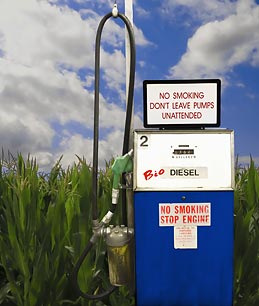
The promise of biofuels like ethanol is that they will someday help the world grow its way out of its addiction to oil. Nine billion gallons of corn ethanol were produced in the U.S. in 2008, while countries like Brazil have already widely replaced gasoline with ethanol from sugar cane and countless start-ups are working to bring cellulosic and other second-generation biofuels to market. The reasoning is that if we use greener biofuels in place of gasoline, it will significantly enhance our effort to reduce greenhouse-gas emissions.
But the question is, Are biofuels really green? A pair of new studies in the Oct. 22 issue of Science damningly demonstrate that the answer is no, at least not the way we currently create and use them. In the first study, a team of researchers led by Jerry Melillo of the Marine Biological Laboratory in Woods Hole, Mass., projected the effects of a major biofuel expansion over the coming century and found that it could end up increasing global greenhouse-gas emissions instead of reducing them. In the second paper, another team of researchers led by Tim Searchinger of Princeton University uncovered a potentially damaging flaw in the way carbon emissions from bioenergy are calculated under the Kyoto Protocol and in the carbon cap-and-trade bill currently being debated in Congress. If that error in calculation goes unfixed, a future increase in biofuel use could end up backfiring and derailing efforts to control global warming, according to the paper. “Biofuels can be an important part of the portfolio of climate-change activities,” says Steve Hamburg, chief scientist for the Environmental Defense Fund and a corresponding author on the second Science paper. “But we have to make sure we incentivize the right way, or we could end up with perverse outcomes.”
The problem is that biofuels are treated as if they were 100% carbon neutral, even though they are clearly not. When ethanol is burned, for instance, it still releases CO2 into the atmosphere. After all, the plants that go to make biofuels are made of carbon, just as oil and other fossil fuels are. Further, the use of biofuels would reduce total greenhouse-gas emissions only if their creation were to increase — or at least not displace — existing plant growth, which naturally takes carbon out of the atmosphere. For example, if the wood chips left over from logging were used to make biofuel, overall greenhouse gas emissions would be reduced, since that wood waste would have decomposed on the forest floor and released as carbon into the atmosphere anyway. By using them for fuel, it not only replaces some fossil fuel but also does not destroy plant life.
But that’s rarely how it works in most biofuel production today. Instead, a long-standing forest might be clear cut in Indonesia and replaced with a plantation of palms to make biodiesel. That’s where the accounting error crops up: we should assess the carbon lost in deforestation when we measure the greenness of biofuels, but that’s not how it works under Kyoto, which simply exempts all CO2 emissions that come from using biofuels. CO2 emissions resulting from deforestation or other changes in the way we use land are not evaluated at all. The result is a huge, if accidental error in the existing global carbon accounting system — and one that now stands to be repeated in the cap-and-trade bill up for debate in Congress. “It’s a very, very large loophole,” says Searchinger, who had done pioneering work on problems of biofuels. “We’re just effectively ignoring what happens on land.”